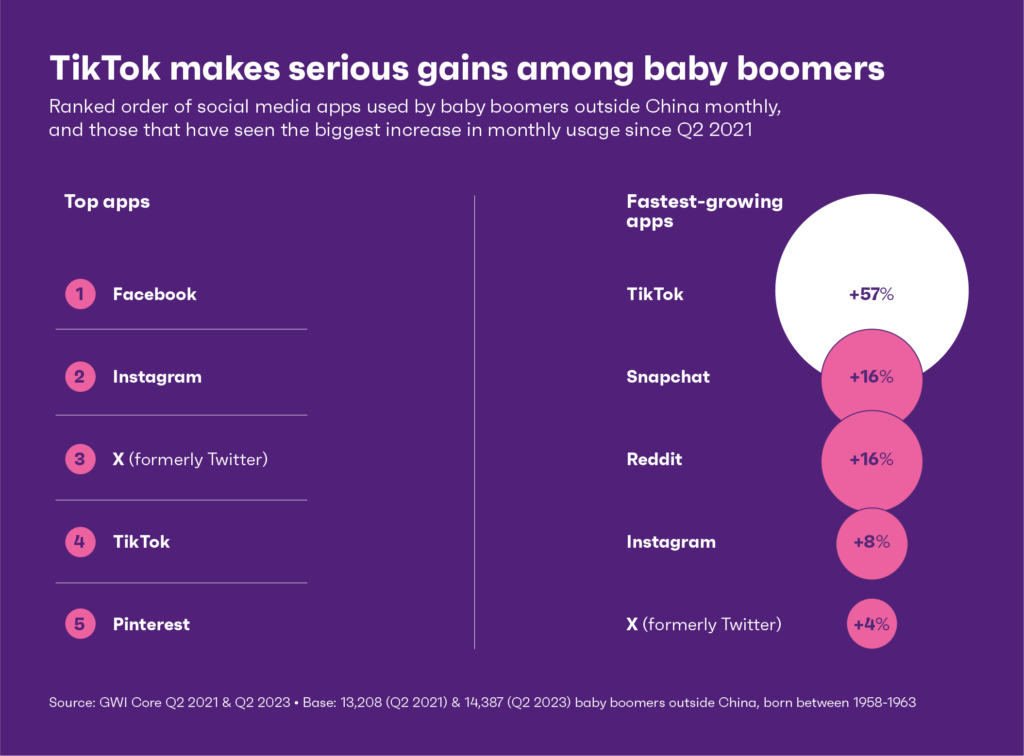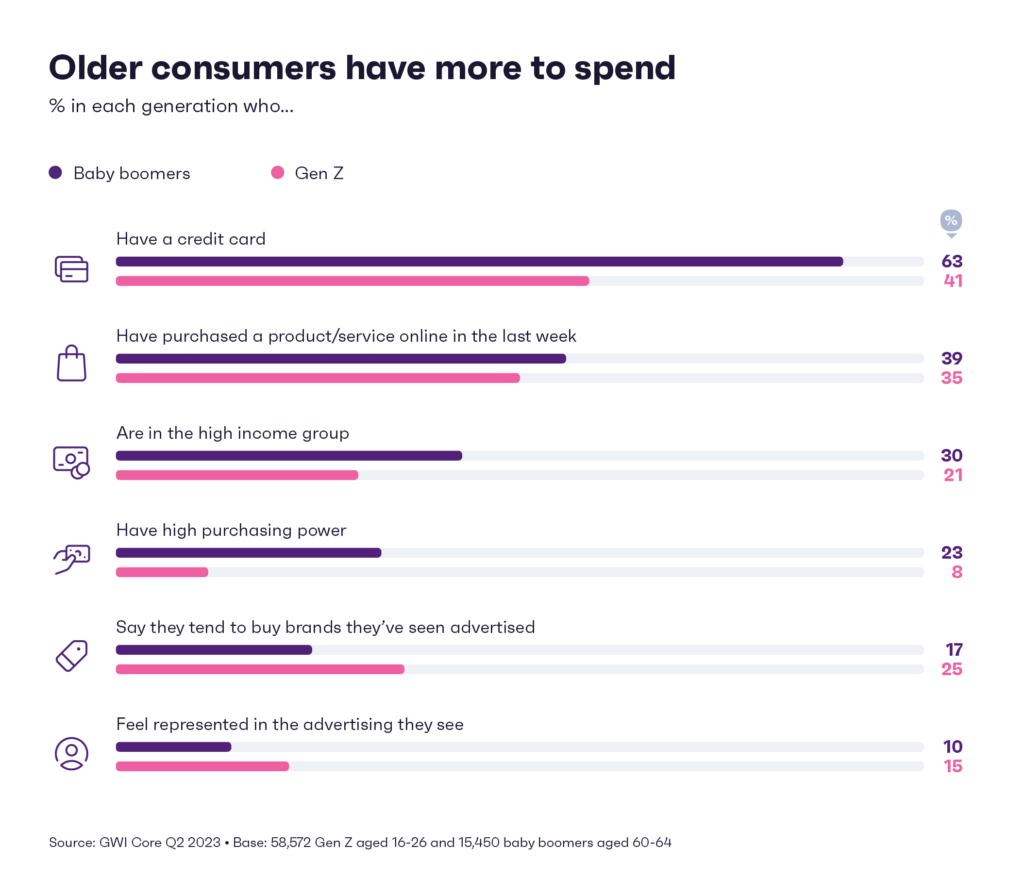One you launch your new Shopify site, you’re going to want to drive as much traffic to it as possible. Whilst we always recommend taking a joined-up strategic approach to any marketing that you do, in this blog, the third in our series helping you to navigate Shopify struggles, we’re going to focus on just one aspect – social media.
Love it or loathe it, social media is part of most our everyday lives. Whether you personally try to avoid it as much as possible, or perhaps just use Facebook to keep in touch with friends and share holiday snaps, it’s likely that many of your customers are far more prolific, making social media the ideal way to reach them directly.
Let’s start by diving into some social media stats.
Must know social media stats for 2024

TikTok remains the fastest growing app, whilst X is experiencing the least growth, however, X is the 3rd most used social network, behind Instagram and Facebook, with TikTok currently the 4th most used.
According to Sprout Social, the average person uses at least 6 different social networks each month and the average amount of time spent online is 143 minutes a day. That’s well over 2 hours every single day.
Video content is the most effective in terms of engagement, with 44% of social media users preferring to learn about products via short form video, whilst marketers report an 87% increase in sales as a result of utilising video content.
According to a report by gwi.com, TikTok use by Baby boomers has grown 57% since 2021.
Defining your audience
Before you can carry out any effective social media activity, you’re going to benefit from going back to basics and kicking things off by clearly defining your target audience.
This is even more important if you’re going to be working as part of a marketing team or will be outsourcing any aspects of your social media, for example paid ads.
Whilst you as the business owner and / or head of marketing will already know who your target audience is, revisiting who they are and clearly documenting that, ensures everyone is on the same page.
Forget what you think you know about different age groups
We’re at a point in time when those in their early 20s are just as likely to opt to attend a book club at a friend’s house or a group craft event on a Saturday night as they are to visit a bar.
Some past generations may scoff at such changes or find this hard to believe, having grown up themselves in a culture where drinking alcohol was pervasive and the default leisure activity, but younger generations are rejecting drinking culture and choosing to spend their precious leisure time (and money) enjoying more wholesome and ultimately more fulfilling pastimes.
The takeaway? Don’t assume that all that 20-somethings are interested in is clubbing, drinking, cars, makeup and fashion. By doing so, we’re doing Generation Z (born 1997 and onwards) a huge disservice and missing a wealth of marketing opportunities.
On the flipside, with an ongoing cost of living crisis, it’s not just younger generations that are feeling the pinch, but once again, we see the spending power of Boomers and their rapidly evolving online spending habits coming out on top.
Be aware that many 60 year olds are far from quietly approaching retirement and are instead loudly, and unapologetically living vibrant lives, quite unlike the lives that their parents were living at the same age!
This means that excluding the young or the old might not be an effective strategy, and makes knowing your target audience, and adjusting perhaps now outdated demographics, vitally important.

Choosing social networks
Whilst Facebook and Instagram remain the top social networks, that doesn’t mean everyone is using them. Facebook in particular is not somewhere you’ll find anyone under the age of 30 actively spending time.
Likewise, older Gen Xers and Boomers in particular are less likely to be active on Instagram and TikTok and more likely to be hanging on to Facebook and X. Not only is knowing your audience important, but knowing which social networks they are most likely to be using is important too.
According to Statistica, you’re most likely reach 18-29 year olds via Snapchat and TikTok, in contrast, if your audience is to be found in the 50+ age group, you’ll find them on Facebook, LinkedIn and Pinterest.
- 18-29 years – Snapchat (41%), TikTok (35%), Instagram (32%)
- 30-39 years – LinkedIn (34%), X/Twitter (34%), Snapchat (33%), Instagram (32%)
- 40-49 years – LinkedIn (25%), Facebook (22%), X/Twitter (21%)
- 50-59 years – Facebook (29%), LinkedIn (24%), Pinterest (24%)
Consider representation in paid social media ads
Regardless of whether your activity is organic or paid for, relevance is key, so you’ll need to understand your audience demographics before you can effectively target your ads towards them.
Each generation wants to feel represented, so the imagery and language you use in your content is of vital importance. To tackle this, you might want to plan a segmented social media campaign, which could mean splitting it by age group or gender.
You might decide to choose different imagery and alter the language used in a campaign aimed at under 50s for example. A female audience might find certain features more compelling, in which case highlighting different information depending on the gender you’re targeting could be beneficial.
Tips for effective social media
Understand what you want to achieve
Setting clear objectives from the outset is a key component when it comes to the measurement and analysis phase. Blindly posting with no clear strategy or objectives is unlikely to provide you with great results; without knowing what you want to achieve, creating consistent calls to action becomes impossible.
For any retailer the ultimate goal of social media is enhancing brand awareness and attracting new customers to your brand.
For most retailers, the primary goal ultimately leads back to the bottom line, which means, sales. Of course community building has its place and can play a vital role for businesses too, and some retailers choose to provide customer services almost exclusively via the likes of Facebook Messenger.
The content that you post on social media will therefore depend on what you want to achieve. If sales is your primary focus, you’ll want to ensure you include information about sales and other promotions, with a clear call to action encouraging website visits and purchases.
If however you want your social media to be more about brand building than generating sales, you’re going to need to find interesting ways to engage your audience and create a sense of community whilst building trust and creating brand awareness.
Consistency is everything
The very worst thing you can do when it comes to social media is be inconsistent. If you’re just getting started, you’ll want to decide on a realistic publishing schedule, for example, posting a minimum of 3 times per week.
Ideally, most social media channels will facilitate growth most effectively with daily posting, however, the quality of your content is critical. That doesn’t mean everything needs to be perfect and polished with Hollywood-worthy production values, far from it, but you don’t want to resort to posting low-value content (explored further below).
Regular posting keeps your brand top-of-mind and encourages ongoing engagement with your audience. By consistently appearing in feeds, you maintain a presence and increase the likelihood of interaction, comments, likes, and shares.
Social media algorithms also tend to favour accounts that post consistently and frequently. Regular posting tells the algorithm that your account is active and relevant, increasing the likelihood that your content will be shown to more or your followers and reach new users.
Beware of low-value content
Although the novelty factor can be an important component in determining the reach and interaction rate of content, relying too much on gimmicks like memes can be detrimental to long-term growth.

Whilst for a small number of brands this kind of trending content can work, for most, and on many social networks, meme-based posts may enjoy much lower reach because it’s regarded as low-value content. This type of content may lack relevance, originality, or creativity, resulting in limited or negative impact on a brand’s social media presence.
With this in mind, you’ll want to avoid;
- Repetitive or overly promotional content that constantly promotes products or services without offering additional value or variety can be seen as spammy or self-serving.
- Content that does not encourage interaction, comments, or shares from the audience may indicate a lack of relevance or interest.
- Irrelevant or off-topic content that strays from the brand’s core message or audience interests could confuse or alienate followers.
- Content that uses misleading headlines, exaggerated claims, or sensationalist tactics to attract attention may damage the brand’s credibility and trustworthiness.
- Content that incites negativity, controversy, or backlash may harm the brand’s reputation and alienate followers.
Understand what content works
Understanding what content resonates with your audience is crucial for effective social media marketing. All businesses are unique and your social media audience is just as unique. This means that whilst there are some general best practices you can consider, what works for one audience may not work for another!
It’s not just the content that matters either. You’ll also need to consider frequency, day of the week and even the time of day you’re posting as these will all impact reach.
Social media content tips and tricks you’ll want to consider;
- Schedule content so it’s posted at peak times – these times will differ depending on your audience.
- Use storytelling techniques to create compelling narratives that connect with your audience on an emotional level.
- Provide valuable (helpful) and relevant content that educates, entertains, or inspires your audience. Solve their problems, answer their questions, and address their needs.
- Monitor the comments section – don’t just post and then ghost, social media is designed to encourage two-way interaction, so respond to comments, questions and opinions, good or bad!
- Encourage engagement and action from your audience by including clear CTAs in your posts, such as asking questions, prompting comments, or inviting them to visit your website to find out more.
- Competitions and giveaways can provide a compelling way to engage with your audience, depending on the entry mechanism you use and the value of the prize on offer, you may find that a giveaway provides you with a large amount of reach and can attract new followers.
- Use good-quality images, videos, and graphics to capture attention and make your content more engaging and consider encouraging and utilising UGC (user generated content) too.
- Be authentic and genuine in your content to build trust and credibility with your audience. That means communicating in a way that’s true to your brand tone of voice and avoiding controversial or negative posts.
Branding matters
Numerous times we’ve found blaring inconsistencies in company branding across social media platforms. Ensure that whatever logo, brand name and tagline you’re using on your Shopify website it is replicated across all social media platforms, and this includes your Google My Business page.
When evaluating your social media presence, remember to not only assess the platforms you are currently active on but also those channels you have chosen to no longer engage with.
A new customer visiting Facebook and seeing an old logo can be confusing at best, but this lack of brand consistency can erode trust and make a business look ultimately, less professional.
You can read more about the importance of brand consistency here.
Caution is advised when working with influencers
Regardless of what kind of influencer you choose to work with, there remains a valuable role they can play in helping brands to reach a wider audience, however, working with influencers requires an entire blog post of its own!
Influencers come in a variety of different flavours, from micro-influencers to celebrities. Deciding which end of the scale you want to work on, will depend on numerous factors like your goals, budget and brand values.
You may choose to work with micro-influencers who might have a social media audience of less than 10k, but who may be viewed as more authentic and trustworthy by their followers. They can also offer great value, may be eager to work with you and may not have any fee’s other than the receipt of gifted products.
At the other end of the scale you may wish to work with minor celebrities who may have several hundred thousand, if not millions of followers. You could benefit from having your products seen by a much larger audience, but you’ll be faced with high fees and your collaboration might not be on their list of top priorities.
You’ll need do your homework and don’t be tempted to say yes to self-styled influencers who approach you, but simply don’t have the audience or reputation to warrant a collaboration. Some really are just after a freebie and have no intention of making the agreement a reciprocal one!
- Check a potential influencers followers and evaluate how genuine and engaged their audience really is.
- Always be very clear when collaborating with an influencer about your expectations, including what you’re offering and what you need them to deliver, and by when.
- Consider a basic contract where you lay out key terms, this can help avoid any confusion, which can be helpful should the influencer fail to deliver.
- Do ensure you remember that this is a collaboration, influencers know their audience best and will have worked with brands before, so don’t be too prescriptive and take on board their ideas and advice too.
Analyse and adapt your approach
However you approach social media, taking an analytical approach will help to determine your success. All of the big social networks include detailed insights and analytics which can help you understand a variety of different behaviours.
From the average length of time people stick around to watch your videos on TikTok, to the number of new followers you’re attracting. Whilst most social networks are keen to put figures like ‘reach’ and ‘impressions’ up front (commonly regarded as vanity metrics), by themselves, these impressive looking numbers are largely meaningless.
The more engaged people are with your content, the more likely they are the consume that content for long enough to take in key messages. When people do that, they become more likely to not only to see your content more often, ensuring your brand is kept top of mind, but they are far more likely to become curious enough to find out more.
- Regularly analyse your social media performance using the analytics tools provided by each platform.
- Identify trends in the data, this will help you understand what type of content leads to the best engagement from your audience.
- Join up the dots by ensuring you are using Google Analytics – this will show you how much of your traffic, and most importantly, Shopify sales, are being generated by your social media activity.
Link to your social media channels
Once you’ve decided on your objectives and which social media channels to use, make sure you list them on your website!
Shopify makes it easy to add your social media links, usually in the footer of your website, so ensure you add the relevant links to your website and keep them updated.